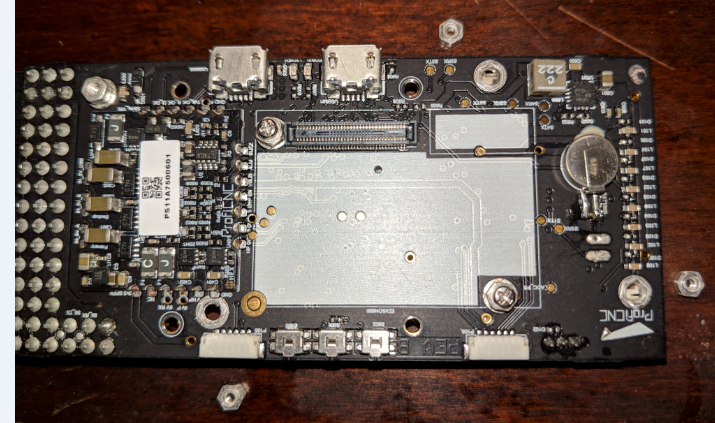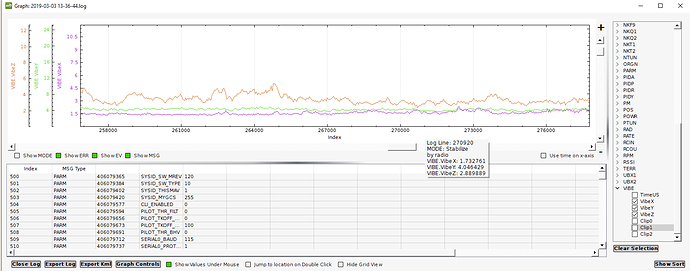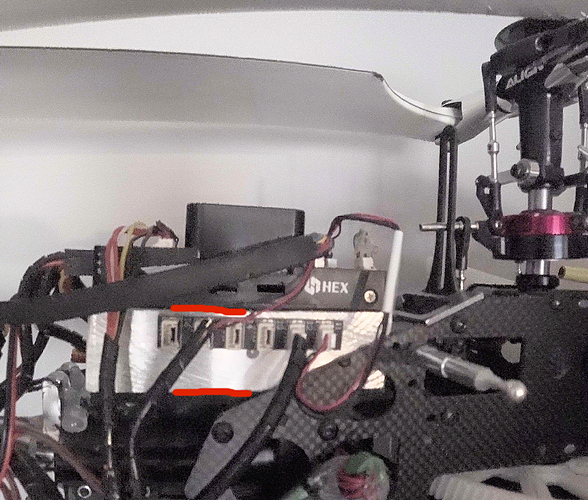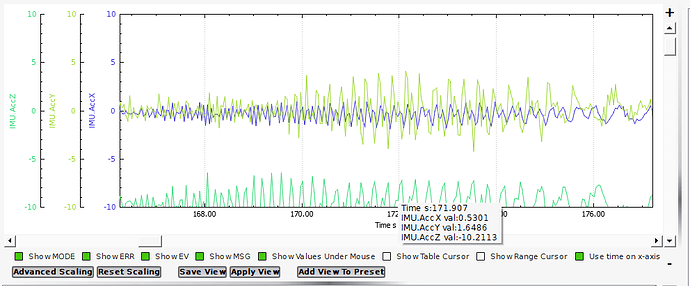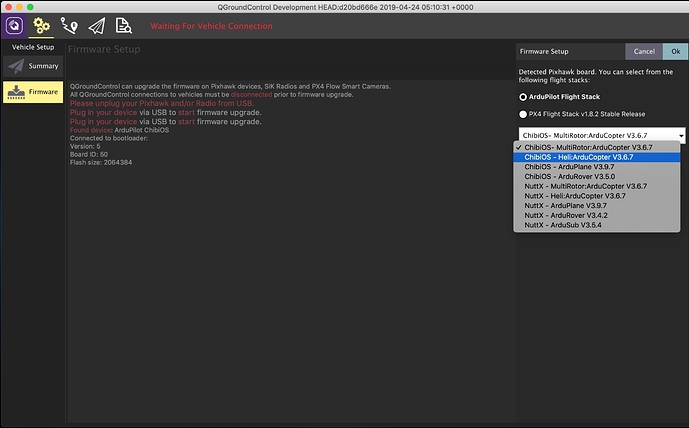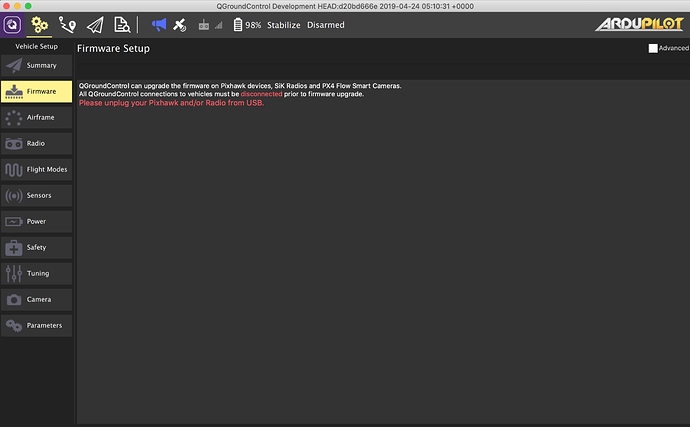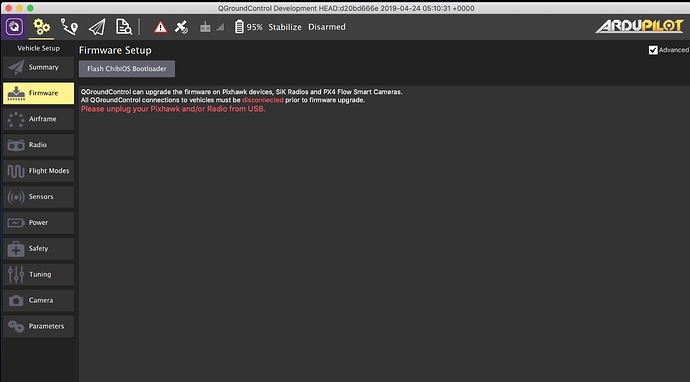hmm, in the video the swashplate is level while in stabilize mode, but tilts up when I switch to loiter mode. Note that the swashplate is level when I switch it back to stabilize mode from loiter. The bench test just to show what it did in flight. When switch to loiter mode it tilted up and then settled down to hover at attitude hold.
I see what you’re talking about. What version of software? I will have to look more closely at the code. If I remember correctly, you were able to get it to hold a stable hover in loiter after you had reworked your rotor head? When I get a chance I will look at this on my heli as well. I hadn’t noticed that behavior or maybe never paid that much attention to it. It seemed like you position keeping in loiter was really good. Mine tends to wander a bit due to the GPS accuracy.
Yes, it held stable hover in loiter after I replaced the entire rotor head assembly. I can learn flying heli nose in for the first time!I am planning to put it in 450 scale Army fusage when I get a new Pixhawk module. My other Pixhawk had several nuts broke off the carry
PWB inside the module(see attached). The module was mounted upside down to the heli frame. As I understand the Cube module and the carry board are help up by four little screws. It did not survive and felt the vibration of the heli. Someone at the factory needs to review the mounting nuts on the carry board for the case the Pixhawk mounted upside down. Needs to beef up the mounting hardware on the PWB.Recommend using a CUAV Pixhack V3x instead. Several of us are getting very good result with that.
Thanks Jakob. Who sell it? and can it be mounted directly to the heli frame and so no need damping mechanism.
Usually from CUAV’s Aliexpress store.
And yes, my Soxos has no damping mechanism. The V3 is also nice, compact and extremely well made.
I believe Chris swears by it as well.
okay thanks. Which version of firmware does it take? is it same version as pixhawk 2.1(cube)?
David, it takes the same firmware. For Copter 3.6 it runs fmuv3 ChibiOS (or can run NuttX if you want). But NuttX will soon be gone from ArduPilot when 3.7 arrives.
I have mine direct mounted in gas helicopters, just stuck to the FBL unit tray with Velcro. It is not much bigger than a typical FBL unit, CNC machined aluminum case, internal damped IMU’s, all end wire hookups, has 5 aux outputs on the servo rail instead of 6 because of its small size. The cube/carrier type boards are great for multicopters, but the V3 is the one I use in heli’s.
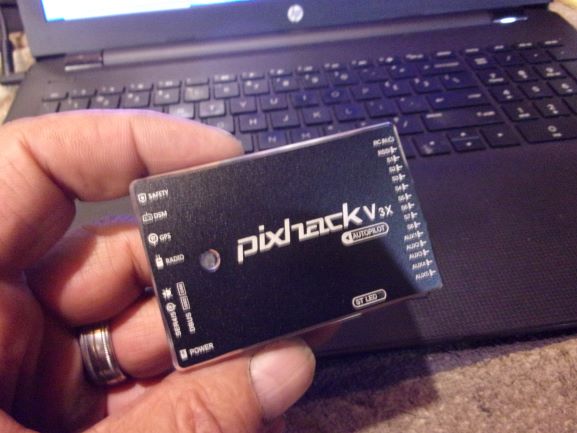
I got this one stuck to that tray in a gas helicopter with velco, mounted right above the engine.

This is what it registers for vibration in flight, never clips the IMU’s ever, even during ground runs. That helicopter handles like a dream.
wow! vibe data looks great. I did not realize the pixhawk cube is not so friendly with heli application in term of form fit. Pixhack V 3x is great. Thanks Chris for the info. Will get one for my 450 heli.
I think it would be perfect for a 450. It is small and fits just about anywhere that’s suitable to mount a controller. It also has no problems with rotation to lateral vibration coupling that can affect the cube type controllers because of their IMU location, especially if they are mounted on a mount that is too soft. The controller has to be able to sense what the frame is doing or it won’t work right. If you isolate it too much and start hanging weights on it to damp vibes the helicopter flies like a pig. BTDT, it don’t work.
Since we’re showing off our good vibrations:
The Soxos 600 has dampers on the tail assembly and tail boom mount which really helps.
Chris, yes I lost about 3 min flying time with that massive Alum-block. Vibration-wise it is working.
Now I am thinking! Could I gain that time back with a pixhack v3x?
I might order one.
Look at the block between the red lines in the photo.
A smaller block did not reduce the vibrations enough. But you are right it fly’s like a pig now.
You have to be careful of wiring too. Sometimes the wiring can transmit vibration to it, especially when the wires are hooked to the face of the board and the wire looms are stiff. Can’t tell from the photo but if that GPS cable sheath is touching the Cube I would be suspect of that.
That is a huge block of aluminum there. With the IMU location in the cube style controllers I can see why it probably don’t fly all that good. CUAV makes the V5 that is sort of like the Cube, but after running both the V5 and the V3, IMO the V3 is a better helicopter controller. During ground run with piston machines, which can be quite long period in cold weather to warm up, sometimes up to two minutes with the rotors turning, the vibration can reach quite high levels. They are not quite as “push button” switch it on and go as electric. If the IMU acceleration reaches 16G then they will clip. But even during ground run the V3 handles it with no problem
If the helicopter goes into ground resonance, which sometimes happens, hopefully you’re at full rotor speed and can punch it get out of there. But sometimes it’s not, especially taking off from frozen ground and it starts reacting against the landing gear. If that happens, the only choice is to cut the power. With electrics you wont’ normally see these issues. But once you go to pistons then it’s more like the real thing and all the “conventional wisdom” on how to mount the controller and damp the things goes right out the window. That mount you have would not last 1 hour in a piston machine. It would destroy the controller, shake the connectors loose off the board, and it would be dead. BTDT too, unfortunately. The closer you can get the IMU’s to the source of the vibration, the better it is.
The block is glued with a thin double sided foam ( industrial strength) to the frame. There is no touching of cables to the cube. Can’t s see that on this photo.
Just hesitating to order because there is no cabling with the pixhack v3.
If I order it as a Set there is a GPS unit and a Power-supply unit plus others what I don,t need… I would prefer if I just could plug the cables in from my present setup and go. But that seams to be not possible. Not desperate at the moment.
All the peripherals you have now works, but different plugs. Your mount obviously works for your particular application. With the piston machines where the vibration is different frequency and have to prevent coupling of the mount or controller with roll and lateral acceleration it requires a completely different approach.
Chris,
I installed last night a brand new very nice Pixhack v3x onto my TR600. The kit came with a GPS and cables.
Everything worked except the old 3DR radio I am still using ( build 2012 but latest FW), never let me down even on different RC aircraft.
Checking and measuring all the wiring I found out that the Radio interface at my Pixhack v3 is supplying 3Volt only. That should not be I believe.
After fiddling with a new wire and supply the 5V required externally the radio started working again flawlessly.
What a nice little FC. Have not flown yet.
No, I think it should be 5V, but I’ve never actually measured it. All my V3 controllers came with a little WiFi radio that I plug into the telemetry 1 port and those work off it. I use that for making settings and uploading a flight plan. They seem to be much faster than telemetry modem radios. Then I have C & T telemetry cable on them on Serial 4 to get MavLink telemetry into the RC, But I am using 900MHz RC, not 2.4GHz. Then on the Serial 2 I have 440 ham band telemetry radios for long-range connection to the GCS. Those radios have external power supply, as they will not power off the telemetry port.
Fred, I like the form factor of the V3 controller with all the end connections and no wires sprouting out of the face of the controller.
Make sure you got the right firmware in it. They come with PX4 pre-loaded using NuttX and I’ve had the GCS identify them as fmuv2 instead of fmuv3 on ChibiOS until I updated the bootloader.
Chris, Could you share the instructions about updating the bootloader on V3 controller?Where do I go to get the correct firmware for V3 controller? Thanks
That is quite easy.
Connect your board to QGC with the USB cable and choose the latest release version
after this (the board reboots) go back to the same screen and tick the advanced check box at the top
after the box is selected you can see a Flash Chibios bootloader button. Press it and done…
If you really, really want to be sure, then download the firmware file from ArduPilot firmware : /Copter/stable/fmuv3-heli
and flash it manually
then proceed to update the bootloader as above.
And done (again) ![]()
